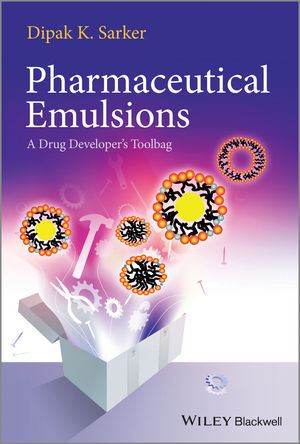
Pharmaceutical Emulsions: A Drug Developer's Toolbag - Kumar Sarker

Descripción
Descripción completa de: Pharmaceutical Emulsions: A Drug Developer's Toolbag - Kumar Sarker
Author : Kumar Sarker
Language: English
Finishing : Hardcover, 206 pages
ISBN : 978-0-470-97683-8
Edition Number: 2013
Author Information:
Dipak K. Sarker
School of Pharmacy and Biomolecular Sciences, University of Brighton, UK
Description:
Pharmaceutical Emulsions: A Drug Developer's Toolbag covers all the key aspects of pharmaceutical emulsions, starting from the fundamental scientific basics, to the pharmaceutical forms and the chemical tests for its application. The author uses his extensive experience in both industry and academic experience to provide a concise, student friendly guide to the essential fundamentals of physical pharmacy.
Divided into three clear sections, the text begins with Section A - Consideration for Product: Medicinal Formulationwhich includes a historical perspective, explanation of what is an emulsion, stability and instability, and manufacture. Section B - Forms, Use and Application follows, with chapters on creams and ointments, pastes and bases, colloids, transdermal, gels and implants. The final Section, Tests: Chemistry to control the quality, efficacy and fitness for purpose of the product includes chapters on physic-chemical properties, sizing and microscopy, rheology, QC and finally questions, calculations and dilemmas. Throughout the text there are numerous figures, diagrams and tables to engage the reader.
This is an invaluable reference for all students of pharmaceutical sciences, pharmacy industrial pharmaceutical sciences, physical pharmacy and pharmaceutical forms as well as industry professionals
Table Of Contents:
- Mathematical symbols (with normal units) xi
- Acronyms and abbreviations xiii
- Preface xv
- Acknowledgements xvii
- About the companion website xix
I Product considerations: medicinal formulations 1
1 Historical perspective 5
- 1.1 Landmarks 5
- 1.2 Significant discoveries 7
- 1.3 Difficulties 8
- 1.4 Traditional uses 10
- 1.5 Product regulation 13
2 What is an emulsion? 15
- 2.1 States of matter 24
- 2.2 Summary thermodynamics 34
- 2.3 Interfacial tension and wetting 36
- 2.4 Shear and size reduction 46
- 2.5 Raw materials 47
3 Stability, metastability and instability 49
- 3.1 Stokes’ law 51
- 3.2 Derjaguin–Landau–Verwey–Overbeek (DLVO) theory 52
- 3.3 Interfacial rheology 56
4 Manufacture 63
- 4.1 Premixing 63
- 4.2 High-shear mixers and size reduction 64
- 4.3 Multiple and microemulsions 65
- 4.4 Hot melt (steriles) 65
- 4.5 Filling 66
II Forms, uses and applications: biopharmaceutics 67
5 Creams and ointments 69
- 5.1 Nutraceuticals and cosmeceuticals 71
- 5.2 Medicinals 71
6 Pastes and bases 77
- 6.1 Emolliency 77
- 6.2 Suppositories 78
- 6.3 Pessaries 79
7 IV colloids 81
- 7.1 Needle free 86
- 7.2 Ocular therapy 87
- 7.3 Cancer 88
- 7.4 Antimicrobials 90
- 7.5 Temperature-sensitive matrices and release forms 93
- 7.6 Targeted endosomal use 94
- 7.7 Solid lipid nanoparticles 95
- 7.8 Diagnostic emulsions 98
8 Transdermal patches: semisolids 99
- 8.1 Hormones 104
- 8.2 Analgesia 104
- 8.3 Anaesthesia 104
- 8.4 Nicotine 105
- 8.5 Inserts: vaginal rings 105
9 Gels 107
- 9.1 Micro- and nanogels 107
- 9.2 Semisolids 107
10 Implants 109
- 10.1 Plastics and glasses 109
- 10.2 Thermoresponsive materials 110
11 De novo science, sustainable novel products and platform applications 111
- 11.1 Tablets 113
- 11.2 Metered-dose inhalers 113
- 11.3 Blood substitutes 114
III Tests: chemistry to control the quality, efficacy and fitness for purpose of a product 117
12 Physicochemical properties 119
- 12.1 Thermal evaluation (differential scanning calorimetry) and lipid polymorphs 124
- 12.2 Drug form, log P and Lipinski rules 129
- 12.3 Skin and epithelial models 133
- 12.4 Drug delivery routes 134
- 13 Sizing and microscopy 137
- 13.1 ζ -potential 137
- 13.2 Hydrodynamic diameter 139
14 Rheology, texture, consistency and spreadability 141
- 14.1 Bulk properties 141
- 14.2 Solid-state and nanorheological properties 144
- 14.3 Interfacial properties 144
15 Quality control, process analytical technology and accelerated testing 149
- 15.1 Preformulation, high-throughput screening 150
- 15.2 Industrial concerns 151
- 15.3 Rancimat and other methods 152
- Questions 155
- Guide for readers 155
- Specimen 'test' questions 155
- Answers 168
- References 173
- Index 181
Puedes encontrar este libro tambien en las siguientes categorías

































Valoración: